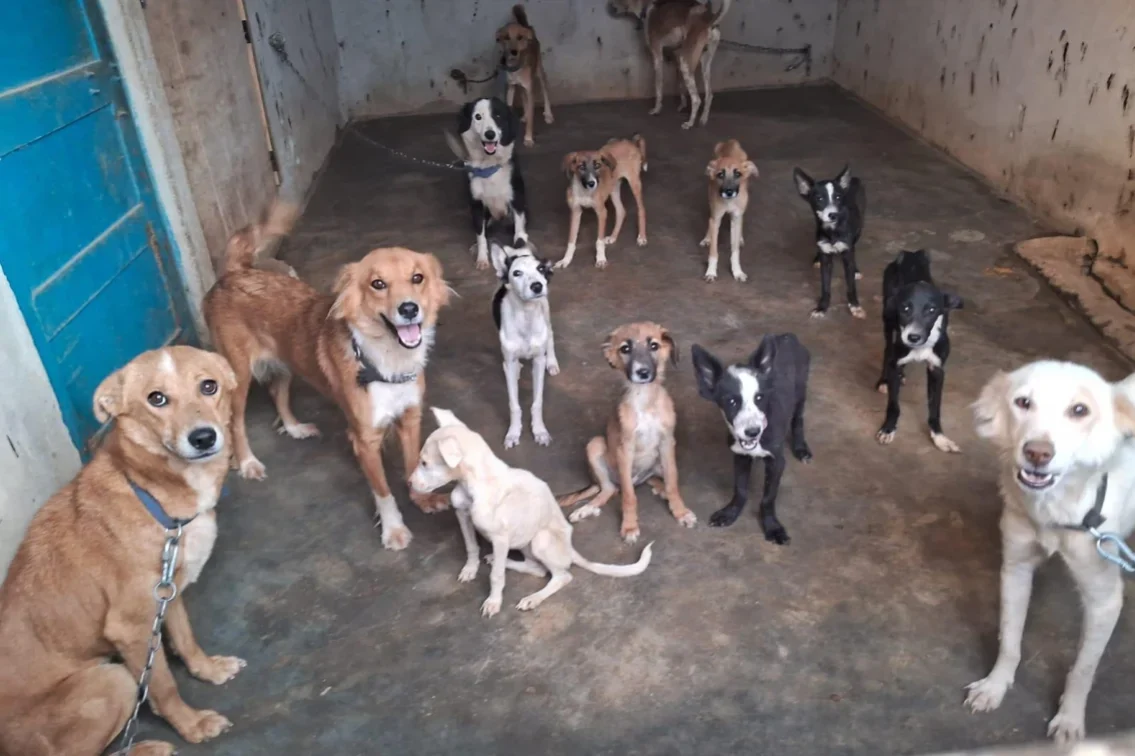When it comes to having a pet at home, dogs are one of the most popular options. They are loyal, playful, protective and simply adorable. However, certain coveted dog breeds that are conventionally kept as house pets such as Huskies, Saint Bernards or Shih Tzus are bred in inhumane conditions and are not suitable for the Indian weather. Adopting such dogs, especially from unethical breeders, perpetuates the cycle of animal abuse. Besides, such dogs are highly expensive to purchase and maintain.
If you’re looking to foster a dog at home, the best route is to adopt a stray dog that needs your help and give it a second chance in life. India is home to thousands of stray dogs or Indie/Indian mixed breeds dogs. Bringing a stray home can be the start of a beautiful friendship, and is the best way to adopt a dog without perpetuating exploitative breeding practices.
At VOSD, we have performed 8000+ dog rescues and have an intake of 200+ dogs every year. You can also support us in our mission to help more stray dogs, by virtually sponsoring a dog.
Why adopt a stray dog?
You give the dog a new lease of life: Dogs that roam the streets or are abandoned have at some point in their lives undergone an immense amount of pain and abuse. By adopting a dog, you give it a chance to live a happy life while being loved and cared for.
You help your local animal shelters: Animal shelters are trying their level best to house stray dogs which can’t fend for themselves and need to be rehabilitated. But, as the count increases, managing the facilities of the shelter can become a tough task. Creating space is a huge challenge, with some mismanaged shelters even resorting to unethical means like euthanizing older dogs. When you adopt or care for stray dogs in your community, you help your local animal shelters take care of another stray dog in need of care.
You become more responsible: Caring for a dog is no easy feat, it requires a dedicated amount of time and effort put in to ensure your newly adopted stray dog feels at home. By setting up schedules, performing basic parenting tasks and just being a good owner to your furry friend, you automatically gain a sense of responsibility and empathy for those around you.
Bear in mind that there are a couple of important things to consider before you decide on adopting a stray dog.
Look up your options to adopt
The first question you should ask yourself is, “Where do I adopt a stray dog from?”. There are two possible locations – a dog shelter and your local community.
If you are living in a gated community or apartment complex, there’s a huge chance you will come across some stray dogs that often scour the community trash cans to scavenge food. You may also come across fellow dog lovers who are regularly feeding the stray dogs in your area. In such a scenario, it’s best to ask your local community first if the dog is already being cared for. They may guide you to adopting a new puppy litter that has already been weaned by its mother and is old enough to fend for itself, or another dog that could benefit from personal care and attention away from the pack.
Adopting a stray dog from a shelter is a good option especially if you are keen on taking in a particular breed of dog without perpetuating unethical breeding. Animal shelters house a variety of breeds that have been brought in via rescue programs or abandoned by a previous owner who is rendered incapable of caring for the dog. A good animal shelter will also have a record of the dog’s behavioural patterns and medical history, making it easier for you to adopt.
Building a bond with your adopted dog
Most stray dogs were once pets, or belonged to a long line of domesticated breeds that were unfortunate to undergo stressful situations like abandonment and cruelty. Establishing a friendship with a stray dog is an essential part of the pre-adoption process. To do this in the quickest possible time, offer some food to the stray dog and then back away a few metres to ensure the dog does not sense any hostility.
Repeat this process over the next few days till you notice the dog proactively approaching the feeding spot – this is when you know the stray dog considers you trustworthy, thereby forming a bond.
When at your local animal shelter, spend a good amount of time with the dog of your choice before taking it home. A few belly rubs and ear scratches go a long way in developing a strong bond.
Pay a quick visit to the vet
Dog shelters will have the medical history and vet visit calendar laid out for you. If you are picking a dog off the street, it is extremely important to pay a visit to the vet before adoption. Indie/Indian mixed breed stray dogs are typically more resistant to diseases than their domesticated counterparts, but you should never neglect a vet visit as you can help the stray dog gain preventive measures to common issues like tick fever and mange. If you are caring for the stray dog and are yet to bring it home, consider spaying/neutering as it will prevent you from becoming an unwilling pet parent to a bunch of puppies and helps control the stray dog population in your locality.
Set up a dog-friendly atmosphere at home
Just like how humans instinctively prepare their home for the arrival of a newborn child, your new furry friend will greatly benefit from living in a space that is designed to be dog friendly. Here’s a quick run-through of the various spaces in your home that could use some tweaking to appeal to your new dog.
The basics: Clean sweep your home for any instances of loose wires and sharp objects. This should help your dog trod more safely and happily around. Install a guard-rail if you have an open balcony.
The furniture: Pick soft, easy-wash fabrics that cover your furniture, and avoid furnishings that are white or black. Remember to create wider spaces between the set-up of your furniture. Also, store any loose books or paperwork away on shelves – you don’t want your teething pup biting into those snackable items!
The toiletries: You should consider investing in an extra shelf for the bathroom to keep all the dog-specific cleaning and grooming items.
The kitchen: We all know the incredible sense of smell a dog possesses. This is the part of your home that you need to be extra cautious with. Keep strong-smelling foods like onions, garlic and other spices out of reach of your dog. And, make sure that these certain foods that can harm dogs are not left in the open in your kitchen.
The wardrobe: Dogs love to chew on fabric, so you better keep the most expensive of your clothing items locked up good.
Pampering essentials: To make your newly adopted dog truly feel at home, it’s always good to introduce a toy. A ball it can play fetch with or a chewable object designed for teething puppies. You can even give it a collar as a member-of-family identity.
Training your dog
The final step in adopting a stray dog is to complete its transition from being a stray to becoming a house pet. To achieve this, training your newly adopted dog to develop a daily routine is essential. Stray dogs are used to being out and about, so having scheduled walks will help it exert that pent up energy. If you’ve adopted a stray puppy, make sure to have it toilet trained. Also, don’t rush to introduce your dog to guests, understand its social patterns and level of comfort before you take such measures.
Dog breeds that are native to India
Indian pariah dog: The earliest breed to have been found in native to the country. They have a short, stocky build and come in tan, fawn, or brown shades of fur. Some of them are territorial, making them ideal guard dogs.
Indian spitz: Introduced by the British during the 19th Century, these dogs are characterized by their white fluffy coat of fur and pointed muzzle. They make an ideal companion to children. But please be careful, some are known to have mood swings.
Kombai: Found usually in Kerala and Tamil Nadu, these dogs have a square-ish and muscular build. The signature look is their black muzzle. An extremely loyal dog, with proper training it can become an ideal guard dog and companion.
Mudhol hound: The long and lean build makes these dogs expert hunters. They are not suitable as house pets as they are not very sociable and prefer the great outdoors where they can run free.
Jonangi: Native to Andhra Pradesh, these dogs are characterized by their short hair that is covered with spots. They are also known to yodle rather than bark! An ideal companion to have if you like a morning run as they have great stamina and pace.These dogs are not suitable for lazy apartment life. They may not get the exercise and outdoor time they require.
Kanni: A very common breed found in Tamil Nadu, the Kanni’s build of a long snout, lean legs and long tail make them excellent hunters. They are also easy to train and can be great guard dogs.
Frequently Asked Questions(FAQ)
1. What is an indie breed dog?
Indie breed dogs are native to the Indian subcontinent and are from the family of Pye-dogs. Indie dogs are easily trainable and very friendly, hence are suitable for first-time parents, around children as well as to be used as police guard dogs. They are also known as the Indian Pariah Dog and the South Asian Pye dog.
2. Are indie dogs aggressive?
Indie dogs are inherently friendly and good with people and kids. In some cases, they might show aggression towards unfamiliar people and strangers. This trait is a result of them being on the street and experiencing traumatic interactions with humans for years. Stray dog adoption has made it possible for these dogs to have a home and be treated with the love and care they deserve.
3. Are indie dogs good pets?
Due to their friendly and adaptive nature, Indie dogs make for great pets. They are great companions for your little ones and are very low maintenance. Like all dogs, they are also loyal and hence, many people nowadays are considering indie dog adoption.
4. Can indie dogs be trained?
Indie dogs are highly intelligent and independent in nature. They can be easily trained as they are obedient and respectful towards their family. Their adaptive intellect makes it easier for them to grasp instructions and follow them. Start small with simple commands and gradually move on to complex ones.
5. How long do indie dogs live?
The lifespan of an indie dog is between 13-15 years under suitable conditions. If these dogs are left on the street, their life expectancy reduces to a bare minimum of 3-5 years due to the struggles associated with living on the street. If you are a dog lover, consider adopting a stray dog (Indian mixed breed dog) and opt for the Indie breed as they are the most comfortable, friendly and easy-going breed available.





